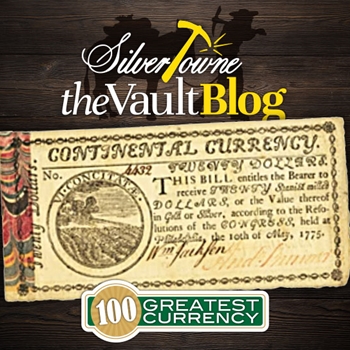
Much like when they were first introduced to numismatics hundreds of years ago, Continental Congress notes have been a popular choice amongst collectors in paper money and the hobby in general. It makes sense that multiple would end up on Whitman Publishing’s 100 Greatest American Currency Notes compilation. Authors Q. David Bowers and David M. Sundman help us get to know more about one of the most special of Continental Congress notes and how its uniqueness made it a top 80 pick.
#79 – Special Marbled-End Paper $20 Continental Currency Note, May 10, 1775
The 1850s were privy to the history of the American Revolution, the members and/or creators of the Declaration of Independence, the life and roles in which our first President, George Washington, lived and breathed, and all the other aspects that laid the foundation of the beginning of the United States of America. Through the beginnings of this nation and the groundwork created, Continental Currency was vital in making it all. The bills have been discussed in historical texts, auction catalogs, and more, which made them a unique niche in the hobby.
This $20 note from the May 10, 1775, Continental Currency series is uniquely different than all others. Not only is it different in size, its format, appearance, and the special paper it was printed on is unlike any other. The paper, which was acquired in France by none other than Benjamin Franklin, is thin and marbled on the left end of the face of the note. This is different than others in the series, printed from 1775-1779, in that the paper is usually thick with mica flakes and were printed by the Ivy Mills in Chester County, Pennsylvania. However, all border engravings for all notes were attributed to David Rittenhouse. He would later be appointed in 1792 to serve as the first director of the United States Mint.
The series of May 10, 1775, was authorized for a total of $3 million and included $1, $2, $3, $4, $5, $6, $7, $8, $20, and $30 denominations. All the denominations authorized except for the $20 and $30 notes printed 49,000 bills. The $30 denomination printed 33,333 notes and the $20 printed just 11,800 on the French paper issue.
Of all the Continental Currency bills from 1775-1779, the $20 note of the May 10, 1775, series is the key issue with no other notes even close to matching its importance.
The historic market value of the notes in 1960 in Very Fine condition was $100. By this publication (2006), the value rose to $6,000. It is difficult to find nice examples of this note due to the marbled-edge paper drying out and crumbling.







